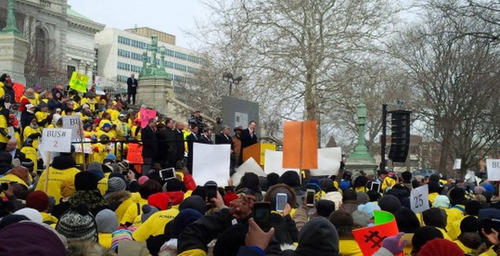 A crowd gathers with signs
A crowd gathers with signs
What Happened in Albany? Interpreting the Massive Parent Turnout in Support of Charter Schools
By George Joseph
March 4th in Albany felt like a massive field trip gone wrong. On the same day that New York City Mayor Bill de Blasio rallied over a thousand students, parents, and labor activists to the capital in support of his signature campaign promise - universal pre-school - about seven thousand school kids, parents, and teachers, bussed in by Success Academy charter school CEO Eva Moskowitz, marched in opposition protesting De Blasio’s decision to charge affluent charter schools rent for the spaces they collocate from public schools and for his administration’s decision to approve “only” five of Moskowitz’s eight proposed colocations for next school year.
A disturbing trademark of “education reform” protests is that the corporations who fund and manage them cannot even entertain the notion that political rallies ought to be democratic. Not only were thousands of charter students pushed out of school to promote Moskowitz’ expansion agenda, Success Academy parents likewise, as has been documented in past rallies, were told that such rallies were “mandatory” - an order that would obviously be illegal if these charter schools were public institutions as they so often claim. Nonetheless, given that hundreds of parents did choose to leave work and were actively taking part in the protest, it would be dishonest to write the whole spectacle off as coerced.
Though some writers have stressed the rally’s use of students and parents as lobbying props, the reality apparent to those present was much more complicated. Many students and parents seemed excited to be there, chanting, carrying signs, and speaking out. Thus, for public school advocates, interested in building a truly grassroots movement to reinvigorate community schools, the hundreds of city parents who made the trip up to Albany, cannot simply be written off as victims of “false consciousness.” It is only by taking their actions and words seriously that we can understand these parents’ attitude towards charter schools, which undoubtedly represent the views of a significant percentage of the city’s working class parents. In fact, according to a recent Quinnipiac University poll, 40% of New Yorkers supported charter school expansion while only 11% favored a decrease in the number of charters schools.
Within the charter ranks at Albany, there was a clear ideological distinction between parents and the officials who had summoned them. According to Izzy Kopis, a Success Academy math curriculum director, the key to her school’s popularity is its union-free campus, “We’re independently run and free from a lot of union rules, so we have a lot of flexibility to choose our curriculum, our school hours, and our quality teachers.” Following the Waiting for Superman template, Kopis attributed her school’s popularity with parents to its ability to bypass teachers’ unions, neoliberalism’s boogeyman for every failure in the public education.
On the other hand, parents, who were willing to speak off the record, commended their kids’ charter schools, though for altogether different reasons. Their comments were not focused on charter schools’ ability to break off from union contracts or freedom to dip into some mystical source of market efficiency; instead, their praise was focused on the extra attention their children received, the smaller class sizes, the higher funding per pupil, the refurbished facilities, and the cutting-edge classroom technology - all needs which policy makers consistently exacerbate in public schools. As Brian Jones, a former teacher and public school advocate explained:
“Parents are doing what they’re supposed to do, fighting for what they think is best for their own kids and who can blame them? We’ve been fighting for these school quality issues for decades, yet today policy makers force parents with the Faustian bargain, ‘Oh, you want arts programing, classroom technology, smaller class sizes? Well then you have to go to charters.’”
Hence, it makes perfect sense that parents seek “choices” to help their kids escape schools with impossible learning environments. What public school advocates must make clear, then, is that the forces behind charter schools are not a response to “failing public schools,” but rather the very cause of them.
“During Bloomberg’s years, our schools faced constant cuts not only to funding but also to space from other public and charter schools,” said parent Miriam Aristy-Farer at the rally. “Our school in Washington Heights went from an A to C rating after getting two colocations we didn’t want. Of course when you gut public schools, people are going to look for alternatives.” Indeed, as Diane Ravitch and Leonie Haimson, founder of Class Size Matters, outline in The Nation, the Bloomberg era was devastating to school quality:
“the size of classes in the early grades are now the largest in fourteen years, and about half of middle and high school students are in classes of thirty or more. Many teachers have 150 students, making it all but impossible for them to look students ‘in the eye’ and give them the individual attention they need—especially students who are disadvantaged.”
It is no coincidence that charter advocates like former New York City Mayor Bloomberg, Chicago Mayor Rahm Emmanuel, and education secretary Arne Duncan have gone significant lengths to destroy the public school system, cynically promoting rapid charter expansion in the wake of massive school closings or natural disasters. As Jones noted, “Charters don’t have a market if public schools aren’t failing. If public schools can provide the same resources and funding, who’s going to wait for a lottery? Their whole model is to feed off the destruction of the public school system.”
Charter schools cannot be neutral. Their very existence is antithetical to the public school system. Charters cannot expand their market share without creating demand; their growth model directly depends on the liquidation of the public school system. Consequently, as Diane Ravitch explained in an email, parents’ demands for quality schools would be “better served by fighting to improve their neighborhood schools rather than promoting academic apartheid.”
Yet as supporters of public education, we must take the concerns of parents considering charter schools seriously, making a good faith effort to provide a positive alternative vision. The 2012 Chicago Teachers Union strike and last year’s community mobilization on the part of the Portland Association of Teachers prove that when the connections between inadequate public services and “education reform” are unabashedly articulated entire communities can band together in defense of their students, teachers, and schools. But as the confusing rally in Albany demonstrates, as long as parents remain divided, clashing over issues as basic as universal pre-K, the struggle to save our community schools will remain at a standstill.
George Joseph
George Joseph is a labor and education reporter, who looks to The Wire and Toblerones for daily inspiration
Catch up with me @GeorgeJoseph94.

